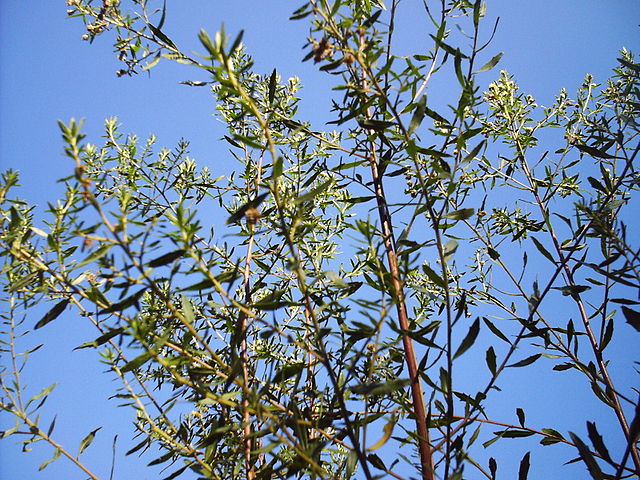Brazilian green propolis is a specific type of propolis that contains Baccharis dracunculifolia resin as its main source. Brazilian Green Propolis health benefits mainly underline those of the plant, in addition to the ones we commonly find in any other propolis, no matter the botanical source.
Propolis is composed mainly of the plant resins and exudates that bees gather. Bees add wax, some secretions, and pollen to it. The composition of propolis depends on its botanical and geographical origin, even weather and hive.
The plants that are harvested by bees are so different that the composition of propolis will never be the same. So, besides the usual dark brown propolis, propolis can also be green, red, black, and with white hues.
And it is quite astonishing that while the composition of the different types of propolis differs greatly depending on their botanical origin, their biological effects are very similar.
Baccharis dracunculifolia DC (Asteraceae) is the main botanical source used by honeybees to produce Brazilian green propolis. Baccharis dracunculifolia is a medical plant found in Brazil. It is mainly used for its antiulcer and anti-inflammatory properties, which is why green propolis also treats ulcers and inflammatory diseases.
The overall content of this propolis type is similar to that of poplar propolis, basically containing balsamic and non-balsamic components. It contains a main part of plant derived substances and minor parts of bee and pollen derived substances. The chemical composition is, however, very different.
The balsam part of poplar propolis originates from the collected glue, while the non-balsamic constituents are added by the bees. The typical components of poplar propolis are the phenolics: flavonoid aglycones (flavones and flavanones), phenolic acids, and their esters. The typical compounds of Brazilian propolis are prenylated derivatives of p-coumaric acid and of acetophenone, as well as diterpenes and lignans. The flavonoids are different from those in ‘poplar type’ propolis.
In December 2014, the Society of Chemical Industry published the Composition of the volatile fraction of a sample of Brazilian green propolis and its phytotoxic activity, made by Fernandes-Silva CC et al. from the University of São Paulo, São Paulo, Brazil. The study runs an analysis of the chemical composition of green propolis and evaluates the phytotoxic activity of the volatile fraction of a sample of Brazilian green propolis.
The chemical composition of the volatile fraction of this Brazilian green propolis is different from the other propolis. According to the study, the “main constituents are the phenylpropanoid 3-prenylcinnamic acid allyl ester (26.3%) and the sesquiterpene spathulenol (23.4%). Several other sesquiterpenes and phenylpropanoids, in addition to linalool and α-terpineol (monoterpenes), were also detected.”
What are the health benefits of green propolis?
In recent years, lots of studies have been done to support the medical use of propolis not only in the ORL area but also internally for a lot of conditions.
B. Dracunculifolia in Green Propolis heals ulcers
The study Baccharis dracunculifolia, the main botanical source of Brazilian green propolis, displays antiulcer activity., by Lemos M et at., published in April 2007, investigated the possibility of using B. Dracunculifolia extract for antiulcer treatment.
This study was undertaken to evaluate the anti-ulcerogenic property of a hydroalcoholic extract of B. Dracunculifolia aerial parts. The analysis showed the presence of cinnamic acid derivates and flavonoids.
The doctors used doses of 50, 250 and 500 mg/kg of B. Dracunculifolia crude extract and positive controls: omeprazole or cimetidine. At the end of the treatment, the percentage of ulcer inhibition was significantly higher in groups treated with B. Dracunculifolia, cimetidine or omeprazole, with all protocols used, compared with negative control groups.
These results were similar to those from studies carried out with green propolis extract. Although more investigations are required, the results of this study suggest that B. dracunculifolia has the potential to be used as a phytotherapeutic preparation for the treatment of gastric ulcers.
Green Propolis has antioxidant and hepatoprotective effects
Baccharis dracunculifolia, the main source of green propolis, exhibits potent antioxidant activity and prevents oxidative mitochondrial damage, by Natalia S.S. Guimarães et at., published in November 2011, shows that B. Dracunculifolia in the Brazilian propolis, contributes to the antioxidant and hepatoprotective effects exhibited by propolis. The study investigated the protective effects of the glycolic extract of B. dracunculifolia (GEBd) against oxidative stress in isolated rat liver mitochondria (RLM). The study shows that B. Dracunculifolia exhibits potent antioxidant activity, protecting liver mitochondria against oxidative damage, and such action probably contributes to the antioxidant and hepatoprotective effects of green propolis.
Green Propolis may treat AMD (Age-Related Macular Degeneration) and skin damage induced by UV irradiation.
The Effects of Brazilian Green Propolis against Excessive Light-Induced Cell Damage in Retina and Fibroblast Cells, by Murase H et al., published in December 2013.
The study investigated the effects of Brazilian green propolis and its constituents against white light (UVA) -induced cell damage in mouse retinal cone-cell line 661W or human skin-derived fibroblast cells (NB1-RGB).
Results. Treatment with propolis and two dicaffeoylquinic acids significantly inhibited the decrease in cell viability induced by white light in 661W. Propolis and its constituents inhibited the decrease in cell viability induced by UVA in NB1-RGB. Moreover, propolis suppressed intracellular ROS production by UVA irradiation. Propolis also inhibited the levels of phosphorylated-p38 and ERK by UVA irradiation.
The study concluded that Brazilian green propolis may become a major therapeutic candidate for the treatment of AMD and skin damage induced by UV irradiation.
Green Propolis has antitumor effects
The study Histone deacetylase inhibitory effect of Brazilian propolis and its association with the antitumor effect in Neuro2a cells, by Ishiai S et al., published in June 2014, examined whether Brazilian green propolis has Hdac (histone deacetylase) inhibitory activity and its contribution to antitumor effects. The results show that Brazilian propolis bears regulatory functions on histone acetylation via Hdac inhibition, and the effect contributes to antitumor functions. An intake of Brazilian propolis also shows preventing effects against cancer.
Green Propolis improves liver metabolism and maintains the integrity of liver tissue in diabetes mellitus.
The study Involvement of liver in diabetes mellitus: herbal remedies. showed propolis’ good benefits in treating complications involved in diabetic liver disease, along with several other herbs with antioxidant properties: Liquorice, Pelargonium gravenolens, Momordica charantia, Dihar, Curcuma Longa, Tinospora cordifolia, Kangen-karyu, Parsley, Chard, Green tea Catechins and Piper sarmentosum. The herbs or the compounds present in herbs have the potential to improve liver metabolism and maintain the integrity of liver tissue in DM.
Brazilian Green Propolis capsules – available on Amazon.
Picture source: Amazon
Green propolis boosts immunity
Brazilian green propolis improves immune function in aged mice, by Gao W et al., published on July 2014, showed that some components in propolis could stimulate immune function in young animals or cultured immune cells in vitro. The results of the study indicate that administration of Brazilian green propolis has a positive effect on innate and adaptive immunity in aged mice.
Related articles:
What is Propolis
Propolis can prevent and treat LEUKEMIA and CANCER
Nigella Sativa, the black seeds, can cure every disease. Come on…
********************
References and picture sources:
http://en.wikipedia.org/wiki/Propolis
Bee Product Science, www.bee-hexagon.net February 2014
“Alecrimdocampo” by flaksbaum – flaksbaum. Licensed under Public Domain via Wikimedia Commons – http://commons.wikimedia.org/wiki/File:Alecrimdocampo.jpg#/media/File:Alecrimdocampo.jpg
‘Bees in green propolis’ picture source: http://www.meliponarioreidamandacaia.com/2011/05/minas-gerais-recebe-denominacao-de.html
‘Green propolis’ picture source: http://www.ttnet.net/ttnet/gotoprd/FO500/999/0/941303238313136373.htm






